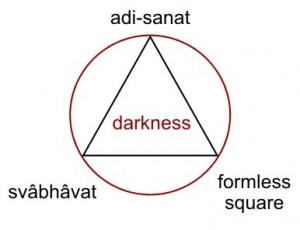“The Occult Catechism contains the following questions and answers:
“What is it that ever is? ” “Space, the eternal Upapāduka.”* “What is it that ever was? ” “The Germ in the Root.” “What is it that is ever coming and going? ” “The Great Breath.” “Then, there are three Eternals? ” “No, the three are one. That which ever is is one, that which ever was is one, that which is ever being and becoming is also one: and this is Space.”
—The Secret Doctrine, vol. 1, p. 11.
*Meaning “parentless” says the footnote in The Secret Doctrine. I have changed the incorrect Anupadaka to the correct Upapāduka.1
As previously identified by comparison with parallel passages in the Buddhist scriptures, the word “space” used in this Catechism is a translation of Sanskrit dhātu.2 This then allowed the word “germ” used here to be identified as a translation of Sanskrit gotra, through the central usage of these two terms in the key text, Ratna-gotra-vibhāga. The Sanskrit gotra has three main meanings in Buddhist usage, as given by D. Seyfort Ruegg:3 1. mine, matrix; 2. family, clan, lineage; 3. germ, seed. Since no single English word has these three meanings, a translator must choose one of them. The first translator of the Ratna-gotra-vibhāga into English, E. Obermiller (1931), chose “germ,” as did the second translator, Jikido Takasaki (1966). Likewise, the first translator into German of parts of this text, Erich Frauwallner (1956), used the German word for germ, “Keimes.” Later translators of this text into English have used “[buddha-] potential” (Kenneth and Katia Holmes 1985), “disposition” (Rosemary Fuchs 2000, Karl Brunnholzl 2014), and “spiritual potential” (Bo Jiang 2017). The normal Tibetan translation of gotra is rigs, choosing the “lineage,” or “family” meaning. Thus, “lineage” was used in a book on the Ratnagotravibhāga by S. K. Hookham (The Buddha Within, 1991), and “spiritual lineage” was used in the English translation of the Bodhisattva-bhūmi by Artemus Engle (The Bodhisattva Path to Unsurpassed Enlightenment, 2016). In the material selected here for translation, I will use “germ” for gotra.
The germ is one, but is spoken of as many:
dharma-dhātor asambhedād gotra-bhedo na yujyate |
ādheya-dharma-bhedāt tu tad-bhedaḥ parigīyate || 39 ||
—Abhisamayālaṃkāra by Maitreya, chapter 1, verse 39.
39. Because the dharma-dhātu is without division, division of the germ is not tenable. But due to the division of the dharmas that are based [on the dhātu], the division of it [the germ] is spoken of.
The word dharma-dhātu has been translated as the realm or basic space of the dharmas (“phenomena,” the “elements of existence”), following the Tibetan translation of dhātu in this compound as dbyings (“realm” or “basic space”). There is another Tibetan translation of dhātu as khams, giving its other main meaning, “element.” As used in the Ratna-gotra-vibhāga, which teaches the one “element,” dhātu is translated as khams. So while the Theosophical teachers used “space” for dhātu in the Catechism, they also spoke of the one “element,” thus using both meanings of dhātu. Here in this verse from the Abhisamayālaṃkāra, the word dharma-dhātu can be understood as the basic space of the dharmas, or as the basic element of the dharmas. The germ or gotra is equated with the dhātu (see below). So since the dhātu is one or without division, the germ must also be one or without division. But since the dharmas that are based on the dhātu are many, so the germ or gotra is spoken of as many.
The germ is of two kinds:
tatra gotraṃ katamat | samāsato gotraṃ dvi-vidham | prakṛti-sthaṃ samudānītaṃ ca |
—Bodhisattva-bhūmi, Unrai Wogihara edition, vol. 1, p. 3; Nalinaksha Dutt edition, p. 2.
What is the germ (gotra)? In brief, the germ is twofold: naturally abiding and developed.
gotraṃ tad dvi-vidhaṃ jñeyaṃ nidhāna-phala-vṛkṣa-vat |
anādi-prakṛti-sthaṃ ca samudānītam uttaram || 149 ||
—Ratnagotravibhāga, chapter 1, verse 149.
149. The germ is to be known as twofold, like a treasure and a fruit tree; naturally abiding without beginning, and later developed.
The germ or gotra has always existed, from time without beginning. In this sense it is called “naturally abiding” or “abiding by nature” (prakṛti-stha). It is likened to a treasure such as gold or gems found in the ground, that has always been there. Yet, if a person on the spiritual path eventually becomes a bodhisattva through the continued practice of virtue, we must be able to speak of development of the germ or gotra. So we may refer to the germ as “developed” (samudānīta). As such, it is likened to a fruit tree with its fruits that develop and ripen.
The germ has three synonyms.
tat punar gotraṃ bījam ity apy ucyate | dhātuḥ prakṛtir ity api |
—Bodhisattva-bhūmi, Unrai Wogihara edition, vol. 1, p. 3; Nalinaksha Dutt edition, p. 2.
The germ (gotra) is also called a seed (bīja), the element (dhātu), and nature (prakṛti).
The germ that is developed, like a seed develops into a plant, may thus be called a seed (bīja). The germ that is naturally abiding or abiding by nature can simply be called nature or natural (prakṛti). The germ as completely identified with the one element can be referred to as such, the element (dhātu). Thus we have the germ in the root.
Notes
1. For how this erroneous spelling arose, see my “Book of Dzyan Research Report, Technical Terms in Stanza I”: http://easterntradition.org/article/Book%20of%20Dzyan%20Research%20Report%201%20-%20Technical%20Terms%20in%20Stanza%201.pdf.
2. See my 2013 article, “The Book of Dzyan: The Current State of the Evidence” (Brahmavidya: The Adyar Library Bulletin, Supplement, 2013, pp. 87-120), which can be found here: http://easterntradition.org/article/Book%20of%20Dzyan%20-%20The%20Current%20State%20of%20the%20Evidence.pdf or http://easterntradition.org/article/Book%20of%20Dzyan%20-%20The%20Current%20State%20of%20the%20Evidence,%20pre-publication.pdf.
3. D. Seyfort Ruegg, “The Meanings of the Term Gotra and the Textual History of the Ratnagotravibhāga,” Bulletin of the School of Oriental and African Studies, vol. 39, 1976, p. 354.
Category: Rootless Root | No comments yet
